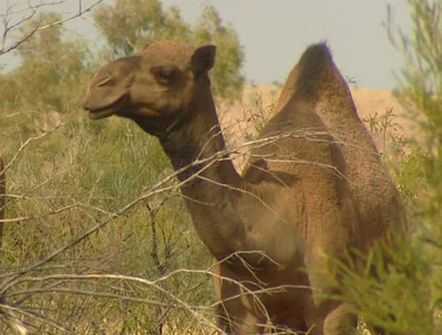牛肉靠邊站,駱駝肉要登場了!一位埃及商人近期向澳大利亞某地方議會提交申請,希望在野生駱駝密集的南部地區開設駱駝屠宰場和肉產品加工廠,并稱此舉不但能解決當地的生態問題,同時還能提供300個工作崗位。如果這項申請獲準,澳大利亞有望于2012年開始對外出口駱駝肉。據這位商人介紹,駱駝肉在所有肉類中是含脂肪量最少的,其外形和口感與牛肉相似,不過,鐵和維生素C含量比牛肉和羊肉都要高。
自1840年由印度引入以來,目前在澳大利亞內陸300萬平方公里的區域內約有100萬只野生駱駝,并且每9年數量就會增加一倍,致使當地生態環境受到破壞。澳大利亞政府于2010年推出駱駝捕殺計劃,投入了1900萬澳元用于治理野生駱駝。

 |
|
?Originally introduced in 1840, mainly from India to provide transport, there are currently more than 1 million feral camels roaming over 3 million square km of outback Australia. |
Move over, beef. Camel meat could become the newest Australian export as early as 2012 if an Egyptian businessman is successful with his bid to open a slaughterhouse and meat processing plant in a rural South Australian town.
Magdy El Ashram's ambitions would not only bring camel meat, which he says is healthier than beef, to dinner tables around the world, it would also reduce a feral camel population in the Australian outback that has caused serious ecological problems, and create up to 300 jobs in a place that badly needs them.
"Camel meat is much better than beef...it's the lesser fat than all the meat kingdom. If you put beef, mutton, kangaroo, emu any meat, then camel meat will be the lesser fat than all of them," he said.
"Camel is a popular food in the Middle East, North Africa and Europe, and Australia has the resources to provide meat to people who like it."
Originally introduced in 1840, mainly from India to provide transport, there are currently more than 1 million feral camels roaming over 3 million square km of outback Australia, breeding at a rate that doubles their population every nine years.
The Australian Federal Government has provided A$19 million ($20 million)over four years to assist in managing feral camels, and a camel culling program began in 2010. The animals cause more than A$10 million a year in damage to fragile outback ecosystems.
"Controlling the numbers decreases the pressure on the landscape in dry conditions and will result in fewer camels dying very cruelly due to starvation, dehydration and trampling," said Jane Ferguson, Managing Director at Ninti One Limited, a management firm in charge of the Australian Feral Camel Managing Project.
"Commercial camel operations need to be driven by economic considerations and need to address the animal welfare issues associated with mustering and transporting wild camels over large distances."
"A LITTLE CHEWY"
El Ashram said he applied Friday to the Port Pirie rural council for permission to develop what would eventually be the largest abattoir in Australia, capable of processing 100,000 animals a year.
This would also include donkey and goat meat destined for the Middle East, North Africa and Asia.
Wild camel feeds largely on grasses and could be viewed as a high quality "organic" alternative to purpose farmed stock, according to El Ashram. Licensed musterers would deliver the animals.
"Obviously it's a good environmental solution and it will bring important employment alternatives to the area," Port Pirie Mayor Brenton Vanstone said.
And the flavour?
El Ashram describes camel meat as similar to beef in the shape and smell, but richer in iron and vitamin C than both beef and lamb.
"The only thing about camel is, if it's aged it's a bit chewy," he said. "But that's the same case with an old cow."
相關閱讀
(Agencies)

(中國日報網英語點津 Helen 編輯)